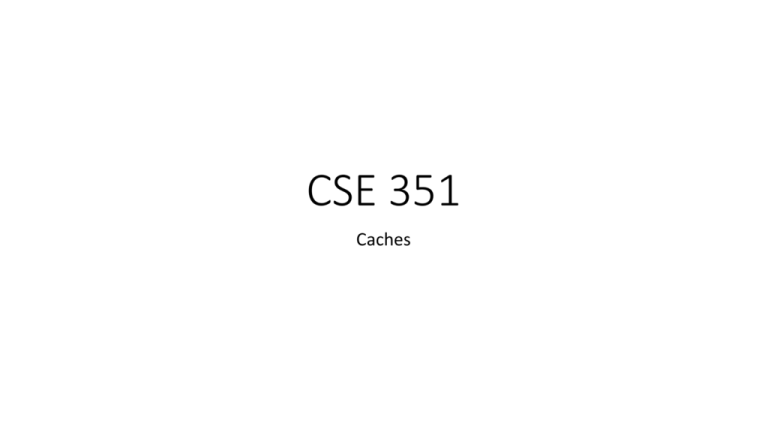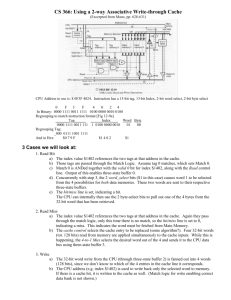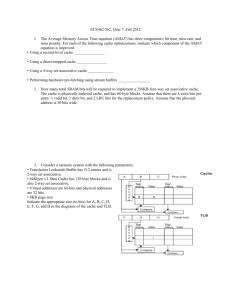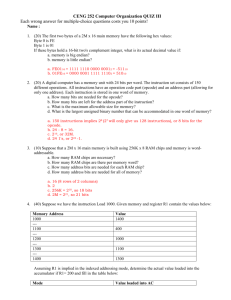CSE 351
advertisement

CSE 351
Caches
Section Feedback
• Before we begin, we’d like to get some feedback about section
• If you could answer the following questions on the provided notecard
that would be great:
• What is working?
• What is not working?
• What should we start doing?
• This is anonymous! Don’t put your name on the notecard
Cache Summary
• Fast memory that exists between registers and main memory
• Takes advantage of temporal + spatial locality
• Temporal locality: Programs often access the same location multiple times
• Spatial locality: Programs often read/write to adjacent locations
• Caching can greatly reduce the number of accesses to main memory
• Programs run much faster this way
• Caching is taken care of by the hardware
• Programmers do not have explicit control over the caches
Cache Associativity
• Determines the number of different locations a given address can
map to in the cache
• Ex. Cache associativity = 1 (direct-mapped)
• This means that every address has only one possible line it can map to
• Ex. Cache associativity = Cache size / Block size (fully-associative)
• This means that any address can map to any line of the cache
Cache Mapping
• To determine where addresses map into a cache, you need to break
the address space up into TAG, SET, and OFFSET bits
•
•
•
•
Work from right to left
The log(B)-most bits are used to express block offset
The next log(S)-most bits are used to express the set number
The remaining bits represent the tag
Cache Mapping
• Why do we order the bits TAG|INDEX|OFFSET?
• This allows caches to capitalize on locality
• OFFSET bits are the lowest-order bits
• Adjacent addresses are thus in the same block
• Takes advantage of spatial locality
• INDEX bits are next
• Adjacent blocks are in different sets
• Takes advantage of temporal locality
• The location of the TAG bits is a result of the placement of the first
two sets of bits
Example Cache: direct-mapped
Set
Valid
Tag
B0
B1
B2
B3
Set
Valid
Tag
B0
B1
B2
B3
0
1
15
63
B4
C1
A4
8
0
-
-
-
-
-
1
0
-
-
-
-
-
9
1
00
01
12
23
34
2
0
-
-
-
-
-
10
1
01
98
89
CB
BC
3
1
0D
DE
AF
BA
DE
11
0
1E
4B
33
10
54
4
0
-
-
-
-
-
12
0
-
-
-
-
-
5
0
-
-
-
-
-
13
1
11
C0
04
39
AA
6
1
13
31
14
15
93
14
0
-
-
-
-
-
7
0
-
-
-
-
-
15
1
0F
FF
6F
30
00
Example Cache: 2-way set associative
Set
Valid
Tag
B0
B1
B2
B3
Set
Valid
Tag
B0
B1
B2
B3
0
0
-
-
-
-
-
0
0
-
-
-
-
-
1
0
-
-
-
-
-
1
1
2F
01
20
40
03
2
1
03
4F
D4
A1
3B
2
1
0E
99
09
87
56
3
0
-
-
-
-
-
3
0
-
-
-
-
-
4
0
06
11
23
6A
42
4
0
-
-
-
-
-
5
1
21
DE
AD
BE
EF
5
0
-
-
-
-
-
6
0
-
-
-
-
-
6
1
37
22
B6
DB
AA
7
1
11
00
12
51
55
7
0
-
-
-
-
-
Example Cache: fully-associative
Set
Valid
Tag
B0
B1
B2
B3
Set
Valid
Tag
B0
B1
B2
B3
0
1
1F4
00
01
02
03
0
0
-
-
-
-
-
0
0
-
-
-
-
-
0
1
AB
02
30
44
67
0
1
100
F4
4D
EE
11
0
1
34
FD
EC
BA
23
0
0
77
12
23
34
45
0
0
-
-
-
-
-
0
0
-
-
-
-
-
0
1
1C6
00
11
22
33
0
1
101
DA
14
EE
22
0
1
45
67
78
89
9A
0
0
-
-
-
-
-
0
1
01
70
00
44
A6
0
1
16
90
32
AC
24
0
0
-
-
-
-
-
Example Problems
• The caches on the previous slides have the following properties:
• 64 byte cache size
• 4-byte block size
• The associativity varies
• Assume an 11-bit address space
• Data is 1-byte addressable
Example Problems
• Direct-mapped cache:
• READ 0x7AC
• READ 0x24
• READ 0x99F
• 2-way set associative cache:
• READ 0x435
• READ 0x388
• READ 0x0D3
• Fully-associative cache:
• READ 0x1DD
• READ 0x719
• READ 0x2AA
Example Problems
• What is the miss rate for the following code?
• Assume cache size 1 KB, direct-mapped, 16B block size
for (int i = 0; i < 64; i++) {
for (int j = 0; j < 64; j++) {
array[i][j] = 0;
}
}
Example Problems
• In the previous example, what code modifications can change the
miss rate?
• What cache changes can changes the miss rate?
• Changing the cache size?
• Changing the associativity?
• Changing the block size?
Cache Experiments
• Assume we have some way of querying the cache to see whether
certain addresses hit or miss
• What sequences of accesses can help us find more about the cache?
• Block size
• Associativity
• Cache size








